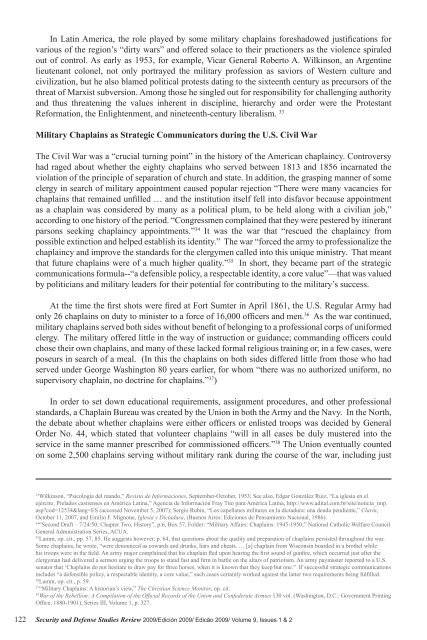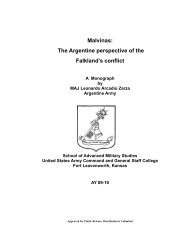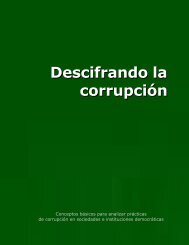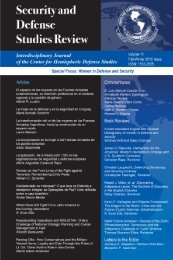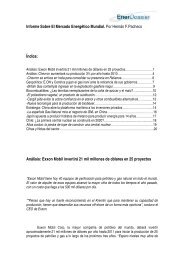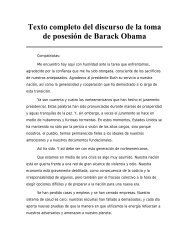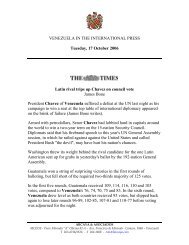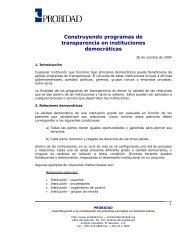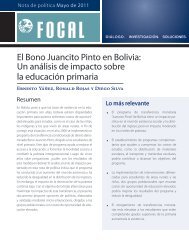In Latin America, the role played by some military chaplains foreshadowed justifications forvarious of the region’s “dirty wars” <strong>and</strong> offered solace to their practioners as the violence spiraledout of control. As early as 1953, for example, Vicar General Roberto A. Wilkinson, an Argentinelieutenant colonel, not only portrayed the military profession as saviors of Western culture <strong>and</strong>civilization, but he also blamed political protests dating to the sixteenth century as precursors of thethreat of Marxist subversion. Among those he singled out for responsibility for challenging authority<strong>and</strong> thus threatening the values inherent in discipline, hierarchy <strong>and</strong> order were the ProtestantReformation, the Enlightenment, <strong>and</strong> nineteenth-century liberalism. 33Military Chaplains as Strategic Communicators during the U.S. Civil WarThe Civil War was a “crucial turning point” in the history of the American chaplaincy. Controversyhad raged about whether the eighty chaplains who served between 1813 <strong>and</strong> 1856 incarnated theviolation of the principle of separation of church <strong>and</strong> state. In addition, the grasping manner of someclergy in search of military appointment caused popular rejection “There were many vacancies forchaplains that remained unfilled … <strong>and</strong> the institution itself fell into disfavor because appointmentas a chaplain was considered by many as a political plum, to be held along with a civilian job,”according to one history of the period. “Congressmen complained that they were pestered by itinerantparsons seeking chaplaincy appointments.” 34 It was the war that “rescued the chaplaincy frompossible extinction <strong>and</strong> helped establish its identity.” The war “forced the army to professionalize thechaplaincy <strong>and</strong> improve the st<strong>and</strong>ards for the clergymen called into this unique ministry. That meantthat future chaplains were of a much higher quality.” 35 In short, they became part of the strategiccommunications formula--“a defensible policy, a respectable identity, a core value”—that was valuedby politicians <strong>and</strong> military leaders for their potential for contributing to the military’s success.At the time the first shots were fired at Fort Sumter in April 1861, the U.S. Regular Army hadonly 26 chaplains on duty to minister to a force of 16,000 officers <strong>and</strong> men. 36 As the war continued,military chaplains served both sides without benefit of belonging to a professional corps of uniformedclergy. The military offered little in the way of instruction or guidance; comm<strong>and</strong>ing officers couldchose their own chaplains, <strong>and</strong> many of these lacked formal religious training or, in a few cases, wereposeurs in search of a meal. (In this the chaplains on both sides differed little from those who hadserved under George Washington 80 years earlier, for whom “there was no authorized uniform, nosupervisory chaplain, no doctrine for chaplains.” 37 )In order to set down educational requirements, assignment procedures, <strong>and</strong> other professionalst<strong>and</strong>ards, a Chaplain Bureau was created by the Union in both the Army <strong>and</strong> the Navy. In the North,the debate about whether chaplains were either officers or enlisted troops was decided by GeneralOrder No. 44, which stated that volunteer chaplains “will in all cases be duly mustered into theservice in the same manner prescribed for commissioned officers.” 38 The Union eventually countedon some 2,500 chaplains serving without military rank during the course of the war, including just33Wilkinson, “Psicología del m<strong>and</strong>o,” Revista de Informaciones, September-October, 1953; See also, Edgar González Ruiz, “La iglesia en elejército. Prelados castrenses en América Latina,” Agencia de Información Fray Tito para América Latina, http://www.adital.com.br/site/noticia_imp.asp?cod=12534&lang=ES (accessed November 5, 2007); Sergio Rubin, “Los capellanes militares en la dictadura: una deuda pendiente,” Clarin,October 11, 2007, <strong>and</strong> Emilio F. Mignone, Iglesia y Dictadura, (Buenos Aires: Ediciones de Pensamiento Nacional, 1986).34“Second Draft – 7/24/50; Chapter Two, History”, p.6, Box 57, Folder: “Military Affairs: Chaplains: 1945-1950;” National Catholic Welfare CouncilGeneral Administration Series, ACUA.35Lamm, op. cit., pp. 57, 85. He suggests however, p. 64, that questions about the quality <strong>and</strong> preparation of chaplains persisted throughout the war.Some chaplains, he wrote, “were denounced as cowards <strong>and</strong> drunks, liars <strong>and</strong> cheats. … [a] chaplain from Wisconsin boarded in a brothel whilehis troops were in the field. An army major complained that his chaplain fled upon hearing the first sound of gunfire, which occurred just after theclergyman had delivered a sermon urging the troops to st<strong>and</strong> fast <strong>and</strong> firm in battle on the altars of patriotism. An army paymaster reported to a U.S.senator that ‘Chaplains do not hesitate to draw pay for three horses, when it is known that they keep but one.” If successful strategic communicationsincludes “a defensible policy, a respectable identity, a core value,” such cases certainly worked against the latter two requirements being fulfilled.36Lamm, op. cit., p. 59.37“Military Chaplains: A historian’s view,” The Christian Science Monitor, op. cit.38War of the Rebellion: A Compilation of the Official Records of the Union <strong>and</strong> Confederate Armies 130 vol. (Washington, D.C.: Government PrintingOffice, 1880-1901), Series III, Volume 1, p. 327.122<strong>Security</strong> <strong>and</strong> <strong>Defense</strong> <strong>Studies</strong> <strong>Review</strong> 2009/Edición 2009/ Edicão 2009/ Volume 9, Issues 1 & 2
40 Catholic priests <strong>and</strong>, eventually, one Jewish rabbi (in 1862 Congress exp<strong>and</strong>ed the law to includeall “religious denominations”). Chaplancy designations included that of post chaplain (created by a1838 law), hospital chaplain (created by law during the conflict) <strong>and</strong> regimental chaplain, followingfederal <strong>and</strong> state laws <strong>and</strong> customs. 39 At the same time, “several hundred Protestant ministers <strong>and</strong> theh<strong>and</strong>ful of Roman Catholic priests” that enlisted in the service of the Confederacy faced the hostilityof the rebel politicians uncomfortable with the idea of state subvention for the chaplaincy.Historian James McPherson holds that the Civil War produced the most religious armies inAmerican history, with military chaplains finding their role reflected an ambiguity in the mission theirsuperiors sought for them, as faith could either re<strong>info</strong>rce a soldier’s fighting spirit, or weaken it. Forthe most religious, McPherson found, the belief that God was watching over them on the battlefieldmeant they entered the deadly frays supported by a “positive religious fatalism,” a phenomenon thatkept the Confederate soldier fighting long past a reasonable expectation of victory. 40 Historian of theConfederacy Drew Gilpin Faust, analyzing the phenomena of religious revivals among Confederatetroops, found that the “obvious cultural resource” encouraged “the group solidarity that modernmilitary analysts have identified as critical to the maintenance of morale,” cultivating continuedresistance even after defeat <strong>and</strong> instilling a “spirit of discipline <strong>and</strong> subordination” even among thosewarriors who fought at a disadvantage. 41 In the words of an officer from one New Engl<strong>and</strong> regiment,cited by the War Department six decades later as “with reference to the influence [the chaplains’ had]over the soldiers as soldiers”: “We count our chaplain as good as a hundred men in a fight.” 42In his study of Union chaplains Warren B. Armstrong found that these “contributed immeasurablyto the ultimate success of the war effort” because of the impact they had on soldiers’ attitudes <strong>and</strong>their conduct at war. The legislative act promulgating the establishment of the chaplaincy showedthe innovation was, motivated to a large part by the desire to provide for the “better organizationof the military.” To some degree, he noted, the chaplains leapfrogged the early justifications of theLincoln Administration for the war—the preservation of the Union—by justifying their role in theconflict on anti-slavery grounds. “Almost universally … both chaplains <strong>and</strong> men evinced a strongantislavery sentiment coupled with a firm conviction that the institution of slavery was at the root”of the conflict. 43The case of Rev. William Corby, chaplain of the 88 th New York Regiment, or Irish Brigade, is oneof the best-known stories of how a chaplain’s personal example was illustrative of religious devotionenhancing the troops’ fighting spirit. Corby, who went on to become president of the University ofNotre Dame, became a hero at Gettysburg after exposing himself to enemy fire as he pronouncedthe absolution of sin of every member of the unit, Catholic <strong>and</strong> non-Catholic, before they rallied tostanch a Confederate assault on Cemetery Ridge <strong>and</strong> Little Round Top. “In the presence of death,”Corby wrote later, “religion gives hope <strong>and</strong> strength.” 44A letter written by a Catholic missionary priest from Wisconsin to President Abraham Lincoln,in which the clergyman complains of a lack of Catholic chaplains in the Union army, requesting thathe be appointed a visiting chaplain to a brigade with appropriate rank, is also instructive. Rev. FrankShroudenback, a German immigrant, claimed in his missive that, at the time of his writing (August 8,1862), even though “more than the 5 th yea nearly the 4 th part of the soldiers in our army are Catholics,<strong>and</strong> though there are about 250 non-Catholic chaplains … there are only about 20 priests in our armyof the U.S. … Hence it follows: that many Catholics are not so prone to enlisting as heretofore.” Inan argument that did not explicitly mention his co-religionists’ belief in the need for the last rights of39“Second Draft – 7/24/50; Chapter Two, History,” ACUA, op. cit., p. 7.40See James McPherson, For Cause <strong>and</strong> Comrades: Why Men Fought in the Civil War (New York: Oxford University Press, 1997), pp. 61-76.41Drew Gilpin Faust, “Christian Soldiers: The Meaning of Revivalism in the Confederate Army,” Journal of Southern History 53 (1987), pp. 81, 88.42Report of the Conference on Moral <strong>and</strong> Religious Work in the Army, p. 6., in Box 57, Folder: “Military Affairs: Chaplains’ Conference, 1926-1940”; National Catholic Welfare Council General Administration Series, ACUA.43Armstrong, For Courageous Fighting <strong>and</strong> Confident Dying: Union Chaplains in the Civil War, (Lawrence: University of Kansas, 1998), p. 3.44William Corby, Memoirs of Chaplain Life: Three Years with the Irish Brigade in the Army of the Potomac, Lawrence Frederick Kohl ,ed. (NewYork: Fordham University Press, 1992) p. 6.<strong>Security</strong> <strong>and</strong> <strong>Defense</strong> <strong>Studies</strong> <strong>Review</strong> 2009/Edición 2009/ Edicão 2009/ Volume 9, Issues 1 & 2 123
- Page 4 and 5:
Document: Speech on “Security, In
- Page 6 and 7:
6Security and Defense Studies Revie
- Page 8 and 9:
un tema de seguridad y defensa porq
- Page 10 and 11:
Los Intereses de la República Popu
- Page 12 and 13:
En el marco estratégico descrito e
- Page 14 and 15:
Works (FAW), Geeley, Dongfeng, y Ch
- Page 16 and 17:
interés en participar en el yacimi
- Page 18 and 19:
al emplear personas locales en todo
- Page 20 and 21:
había un banco en Colombia especia
- Page 22 and 23:
ehén de los FARC, escribe de siete
- Page 24 and 25:
estadounidenses en el futuro, y por
- Page 26 and 27:
26Security and Defense Studies Revi
- Page 28 and 29:
Existe numerosa literatura que trat
- Page 30 and 31:
La Tabla 1.1, demuestra que el apor
- Page 32:
Los cuestionamiento a este modelo d
- Page 35 and 36:
….derogaremos la Ley del Cobre y
- Page 37 and 38:
Figura 4.3.Aporte de CODELCO por ve
- Page 39:
Figura 6.Elaboración propia distri
- Page 42 and 43:
de los proyectos de defensa necesit
- Page 44 and 45:
En el caso de las inversiones en de
- Page 46 and 47:
Anexo 1PROTOCOLO DE ACUERDO QUE ACO
- Page 48 and 49:
OECD. “Models of Public Budgeting
- Page 50 and 51:
proyectos nacionales y democrático
- Page 52 and 53:
DesprofesionalizaciónEn la región
- Page 54 and 55:
Según algunos autores, “no sorpr
- Page 56 and 57:
(antinarcóticos), la Guardia Coste
- Page 58 and 59:
supervigilen las acciones intrusiva
- Page 60 and 61:
Quizás una de las fallas provenga
- Page 62 and 63:
Junto con ello se elaboró una nuev
- Page 64 and 65:
Colombia). Por otro, hay una serie
- Page 66 and 67:
Maldonado, Carlos, “Profesionalis
- Page 68 and 69:
policías y militares no ha estado
- Page 70: La relación entre fuerzas militare
- Page 73 and 74: dictaduras. En aquellos con más tr
- Page 75 and 76: efectos de planificación se ha hab
- Page 77 and 78: BibliografíaAguila, Ernesto y Mald
- Page 79 and 80: Sherman, Lawrence. et.al. 1973. Tea
- Page 81: Influenza Pandemic and its National
- Page 84 and 85: and restaurant services” is expec
- Page 86 and 87: The ability of the health sector to
- Page 88 and 89: BibliographyAlmond, D. and B. Mazum
- Page 90 and 91: El trabajo parte del supuesto de qu
- Page 92 and 93: es tanto una elección voluntaria c
- Page 94 and 95: Por otro lado, Rusia nunca ha visto
- Page 96 and 97: La Organización del Tratado del At
- Page 98 and 99: liquidez internacional pero tambié
- Page 100 and 101: petróleo recientemente descubierta
- Page 102 and 103: Dentro de este esquema, Estados Uni
- Page 104 and 105: 104Security and Defense Studies Rev
- Page 106 and 107: minimize a number of attempts at fo
- Page 108 and 109: kidnapping, of Maria Edith de Deber
- Page 110 and 111: The political campaign that resulte
- Page 112 and 113: would carry out the more violent ta
- Page 114 and 115: of the EPP so far, is the relative
- Page 117 and 118: to accept ideas, policies or course
- Page 119 and 120: eing killed themselves—the idea t
- Page 124 and 125: the Church to be given to the dying
- Page 126 and 127: from providing military chaplains t
- Page 128 and 129: Perhaps one of the clearest example
- Page 130 and 131: was prepared by the Office of the C
- Page 132 and 133: 132Security and Defense Studies Rev
- Page 135 and 136: Keynote Speech by Dr. Frank O. Mora
- Page 137 and 138: If successful, these infrastructure
- Page 139 and 140: Security, Intelligence and the Role
- Page 141 and 142: Clearly, security, intelligence and
- Page 143 and 144: Contratapa(Contratapa offers, in a
- Page 145 and 146: efforts have become intertwined; fo
- Page 147 and 148: comprensión de sus valores y cultu


